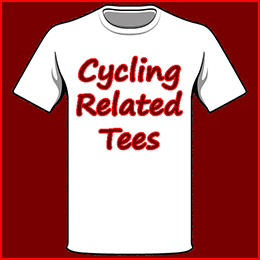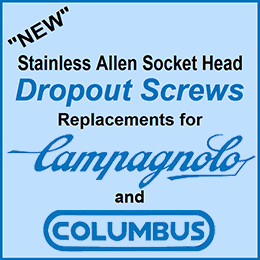Is my vintage frame Reynolds or Columbus?
 Mon, September 10, 2018
Mon, September 10, 2018 
I am often asked this question, and a simple way to identify Columbus is by the spiral ribs inside the front fork steerer. (See picture above.) Vintage threaded steerers that is, not the modern threadless ones. The steerer or steer tube is one of the highest stressed tubes in a bicycle frame, and therefore it has much thicker walls than other frame tubes.
The steer tube is one inch diameter on the outside, throughout its length, (English and Italian.) threaded at the top end and is 7/8 inch diameter on the inside, making a wall thickness 1/16 of an inch. At the bottom end the wall thickness tapers on the inside, making the tube walls stronger at the bottom end where it is brazed into the fork crown.
A Reynolds steerer is smooth on the inside, a Columbus steerer has spiral ribs cut into the inside tube walls. If you shine a flashlight down the tube you can see these, or simply feel up inside the hole under the fork crown with your pinky finger.
This has nothing to do with SL or SLX, the ribs were always there in the steer tube since the beginning, it was the Columbus trade mark. In the late 1980s Columbus brought out the SLX tubeset, with the spiral ribs cut into the butted tube ends of the top tube, down tube, and the bottom end of the seat tube. The chainstays also had the spiral ribs at the bottom bracket end.
Later there was a TSX tubeset introduced (T for total.) where the spiral ribs were cut throughout the full length of the tube. The spirals ribs are cut into the tube with a Broaching Machine. In a similar way rifling is done in a gun barrel.
Actually the material is cut from the inside of the tube, leaving behind the raised ribs. Removing material of course reduces weight, but the spiral ribs give the tube a resistance to twisting, making for a stiffer frame.
To explain further, imagine a coiled spring. Twist it one way and it will expand as the coils unwind. Now twist it the other way and the spring diameter will decrease as the coils tighten. The spiral or helical ribs inside the tube are like a spring, but they are part of a solid wall tube and therefore cannot expand or contract as the tube twists first one way, then the other. Thus the tube has a resistance to twisting.
There is very little twisting stress on a steering tube, it is mostly fore and aft vibration stress. The ribs could have been straight with the same effect. However. What started out as a way to give Columbus a distinct look, turned out to be a legitimate way to remove weight and still retain the tube’s inbuilt resistance to twisting.
 Bike Tech
Bike Tech 


















Reader Comments (4)
Great information, I like learning stuff like this. Thanks.
Really interesting. Now I'm off to look inside my steerer tube.
Thanks for sharing.
Thanks for sharing.